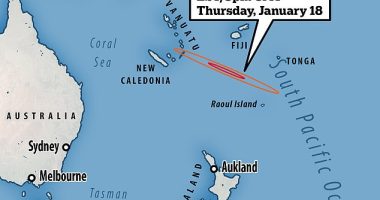
Being exposed to air pollution as a baby, or even while still in the womb, can increase the risk of developing hay fever as you get older, a study warns.
Doctors from Medical University Hospital, Taichung, studied health data from 140,911 infants in Taiwan and satellite images of their home towns to track pollution levels.
They found that those born in areas with high levels of fine particles of pollution were more likely to develop childhood allergies to pollen – known as allergic rhinitis.
The condition results in inflammation of the membranes lining the nose and typically involves symptoms including sneezing, itching and a runny or blocked nose.
The condition doesn’t cause serious health problems, but its symptoms, particularly if severe, can affect social life, school performance, and work life, authors say.
Study authors said they couldn’t say why the link existed, but speculated it could be due to the fact early childhood is a critical stage of development of sinuses.


Doctors from Medical University Hospital, Taichung studied health data from 140,911 infants in Taiwan and satellite images of their hometowns to track pollution levels. Stock image
Several studies have linked fine particles of 2.5 micrometres (PM2.5) in diameter – more than 100 times thinner than a human hair – and allergic respiratory diseases.
But some experts have discounted any such link, and if there is one, it is not clear when the critical period of exposure might be, scientists said.
The period of vulnerability may be during late pregnancy – from 30 weeks – right through to the first year of life, the study suggests.
The babies involved in the study were born in Taiwan between January 1, 2005 and December 31, 2001 and monitored until late 2014.
The final analysis included 140,911 children, a third of whom developed hay fever, which was diagnosed on average when they were around three years old.
To measure exposure to PM2.5 the researchers used a combination of satellite time trend readings, temperature measurements and land use data.
PM2.5 estimates were matched to infants’ residential addresses and calculated weekly, based on the daily average for each infant, researchers said.
Allergic rhinitis was more likely to be diagnosed in boys and in those whose mothers had allergies themselves, scientists said.
Other influential factors included being born prematurely, living in a relatively affluent well educated household and having a mother who had heart disease, high blood pressure or pre-eclampsia.
Having a mother who smoked while pregnant was also a major factor, experts said.
The average weekly PM2.5 levels during pregnancy for all of those involved in the study were 34.26 micrograms per cubic metre.
It was slightly lower during the first year after birth – at 33.56 micrograms per cubic metre, with a positive link emerging between hayfever and PM2.5 when levels are above 25 micrograms per cubic metre.
Those living in an area that saw a 17.98 micrograms per cubic metre increase from 30 weeks pregnant to a year after birth was ‘significantly linked’ to hayfever.
While it is possible to develop hayfever when exposed to pollution from inside the womb, the link is much stronger with exposure after the baby is born.


Study authors said they couldn’t say why the link existed, but speculated it could be due to the fact early childhood is a critical stage of development of sinuses. Stock image
The highest risk happened 46 weeks after birth, the study found.
Each 10 microgram per cubic metre increase in PM2.5 was linked with 30 per cent higher odds of an allergic rhinitis diagnosis and this was significantly higher during the first year of life, scientists said.
When divided by gender, boys seemed more susceptible to pollution exposure during pregnancy than girls, but girls were more susceptible to the effect of pollution exposure as an infant.
Further research is required, the researchers added, but concluded: “Our findings provide further evidence that both prenatal and postnatal exposures to PM2.5 are associated with the later development of [allergic rhinitis].
‘The vulnerable time window may be late gestation and the first year of life.’
The study was published online in the journal Thorax.












